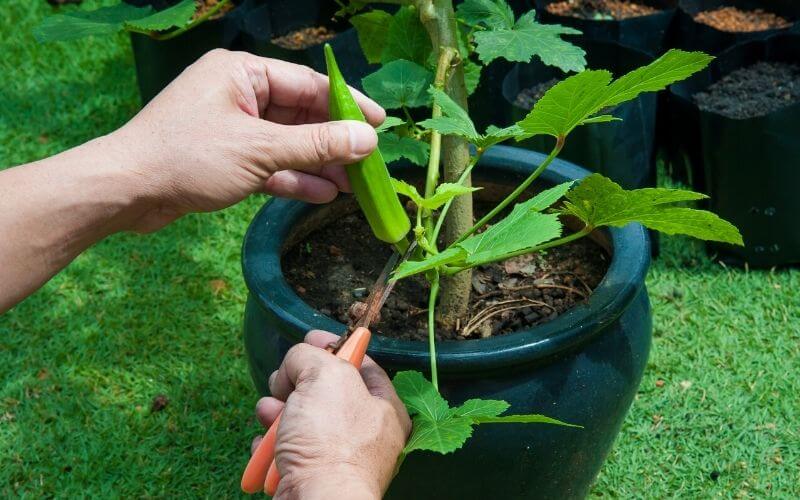
Even if you don’t have a large garden space, you can still learn how to grow okra in containers. Okra grows well in pots because the plants don’t take up a lot of space, and you can enjoy homegrown okra!
Many people assume that they cannot grow okra because they don’t live in a tropical region. While okra is a warm season, tropical vegetable, growing okra in containers allows you to bring the plants inside if the temperatures dip too low.
How To Plant And Grow Okra in Containers
Aside from producing yummy veggies, okra also has beautiful foliage with showy blooms, so it works as an ornamental plant as well. If you’re ready to learn how to grow okra in containers, here is what you need to know.
How to Grow Okra in Containers
Once you selected the type of okra you want to grow, it’s time to learn how to grow okra in containers. It’s much easier than you might imagine!
1: Picking The Right Okra Variety For Containers
Before you plant your okra, you want to pick the right type of okra. Not all okra grows to the same height, and some produce different colored pods.
You want to look for dwarf okra plants that don’t grow above 5 feet tall. Of course, you can grow any variety, but the dwarf ones produce the best when limited in root growth by the container’s size.
If you live somewhere that isn’t a tropical, warm region, you’ll want a variety that matures faster. Here are some of the ideal okra varieties for containers.
2. Choose A Large Container With Drainage
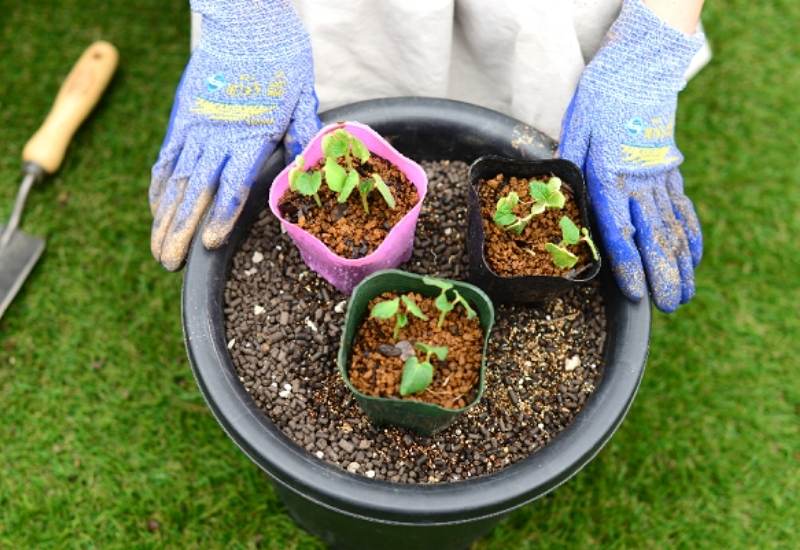
Picking the right sized pot can determine whether or not you’ll be successful at growing okra in containers. Okra has large taproots, so you need a pot that can contain them.
A few suggested materials include:
2. Place Okra Containers In The Right Location
Since you have such a large pot, it’s best to put the container in its specific spot before filling it. Okra requires full sunlight, typically 6-8 hours, to properly grow. Some varieties do better with up to 10 hours of sunlight.
3. Fill The Container With Correct Potting Soil
Okra wants well-draining soil; soggy feet can lead to rotting and death of your plants. To fill your containers, a soilless potting mix full of organic matter is a fantastic choice.
If you use a soilless mix, it should also contain equal parts of sand, peat moss, and vermiculite.
4. Know When To Plant Okra In Pots
Okra isn’t a fan of cold weather or frost; if you live in a region with a first and last frost date, you need to make sure you wait until the danger of frost passes before putting the seeds into the ground.
5. Plant The Okra Seeds In Containers
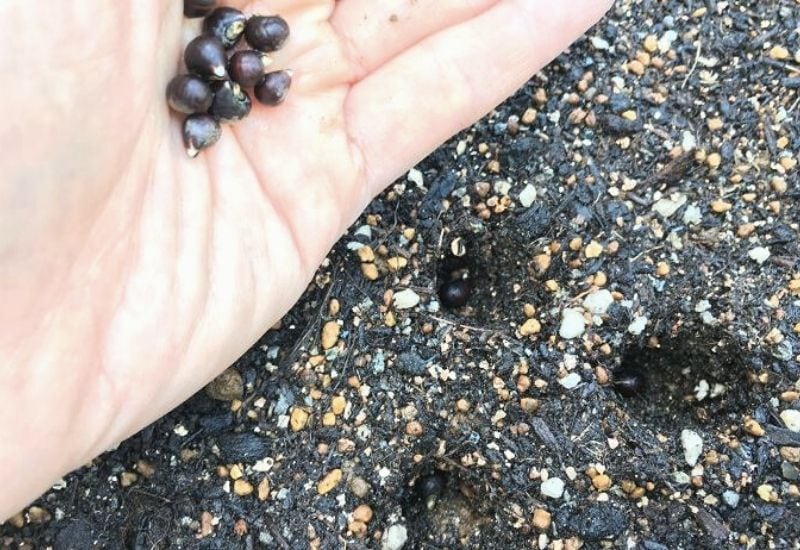
One of the most important things to remember is that okra won’t transplant well due to their extensive root system. If you try to transplant them, chances are you’ll run into a root-bound plant that ends up in shock and dying from the move.
If you find seedlings at your local garden nursery, you might decide to plant those instead of seeds. Okra seedlings have delicate taproots, so you need to be careful when you transplant them into the garden beds.
6. Consider Companion Plants
You might notice that your planter looks bare because okra needs to be placed so far apart. Adding companion plants can help the growth of your okra.
How to Care for Okra in Pots
One reason that people love to grow okra is that they’re relatively easy plants to maintain. They don’t require much care, so here is what you need to remember.
1. How Much Water Okra Needs
Okra plants need uniformly moist and slightly moist soil. You should water your plants regularly. While okra plants can withstand dry spells, they grow the best if they receive 1 inch of water each week.
2. Fertilizing Needs For Okra Plants
In the beginning, you should mix composted manure or compost into the soil to provide nutrients to your plants. You also can side-dress your plants with compost throughout the growing season for additional nutrients.
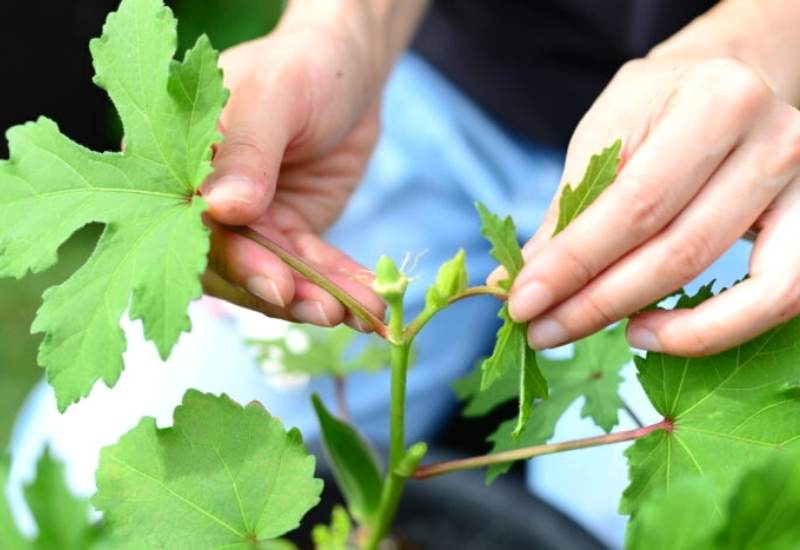
3. Mulch Around Your Plants
Mulching is always a smart idea because it helps the soil retain moisture. If you live somewhere that has hot summers, mulching reduces how often you need to water. Even though these plants can withstand drought, keeping the soil slightly moist for the ideal growth and production.
Harvesting Okra Grown In Containers
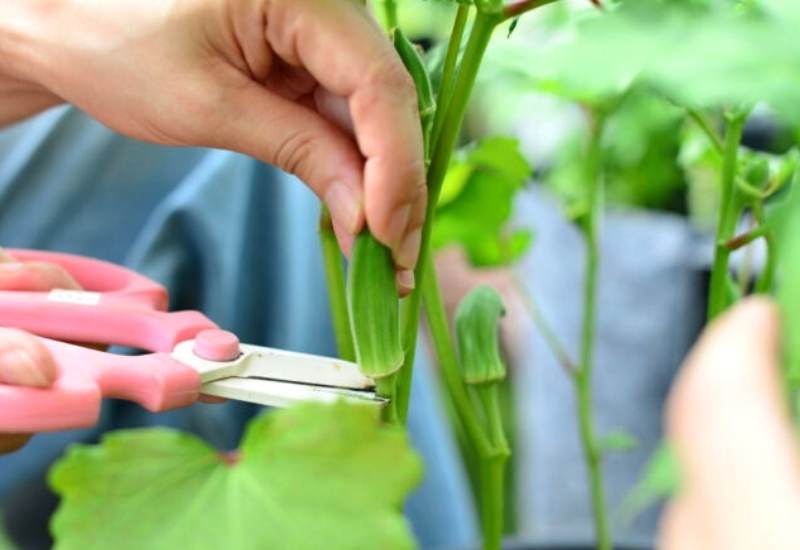
The most important thing to know is that okra plants require frequent and regular harvesting. It takes around 2-3 months after planting for blooms to appear. Once the flowers appear, expect another week before fruits appear.
Okra is a cut and come again plant. They flower nearly every day, and each flower will self-fertilize itself, so you don’t need to worry about pollination. Once flowering, it takes 7-10 days to fruit.
You want to pick the pods when they’re tender. If you wait too long, they become fibrous, making it too hard to be eaten. Aim for each pod to measure between 3-5 inches long.
Common Pests & Diseases That Bother Okra
Okra doesn’t deal with too many pests and diseases; the biggest problem this veggie typically faces is cold weather, but you should be prepared to deal with whatever comes your way.
Fusarium Wilt
Here is another fungal infection that can quickly destroy your crop. Over time, the leaves become necrotic, with the older plants showing signs of wilting first. Severe infections can cause your plants to become stunted and eventually die.
Fusarium wilt tends to develop more in warm temperatures, and there is no way to get rid of the fungus.
Charcoal Rot
With this fungal infection, you’ll notice discoloration of the stem at the soil line, and over time, cankers might spread upwards. It causes the leaves to wilt and eventually drop off of the plant.
Unfortunately, once infected, you cannot get rid of this fungus. It’s best to practice crop rotation to avoid it developing in the soil.
White Mold
This other fungus causes a cottony fungal growth on your plant, along with small, dark green lesions on the pods, branches, and leaves. Over time, the lesions get longer. White mold can live up to 5 years in the soil.
Make sure you rotate your crops and avoid excess nitrogen fertilizer. It’s also best to space the rows wide.
Cucumber Beetles
If your plants are infected with cucumber beetles, you’ll find stunted seedling and damaged leaves. The symptoms often look like bacterial wilt, and there will be scars on the fruit. Cucumber beetles are typically brightly colored with either a green-yellow background and black spots.
You can use floating row cover to protect your plants, and kaolin clay applications are effective in getting rid of small infestations. Applications of insecticides can be helpful.
Loopers
These pests cause large or small holes in the leaves; the damage is often extensive. Cabbage loopers are pale green with white lines on either side of the body. You can typically hold the loopers in check by using natural enemies. Another option is applying Bacillus thuringiensis to kill young larvae.
Root-Knot Nematode
These will lead to galls on the roots, which leads to a reduction in plant growth. They also can cause the plants to yellow in hot weather. Nematodes prefer sandy soils, and make sure you plant resistant varieties if you think they might be present in the soil.
Check the roots in the middle of the growing season if you suspect nematodes. Solarizing the soil can reduce nematode populations.
Final Thoughts
Learning how to grow okra in containers is a simple task for new gardeners. They grow well in most regions, and if you live in a climate that gets cold, growing okra in pots is a smart idea because you can bring it inside if the temperatures get too chilly.

Written By
Bethany Hayes
Bethany is a suburban homesteader, growing over half of the vegetables, fruit, and herbs that her family of six needs each year. She raises chickens and homeschools her children. When she isn’t spending time tending to her garden, you can find her reading, crocheting, and canning.

Hello Bethany,
Is it OK to try for 2 dwarf okra plants in a 10-gallon black plastic pot….I don’t have any 5 gallon pots for this season…..??
Thanks!
Yes it is but remember okra has deep taproots even if you pick a dwarf variety.